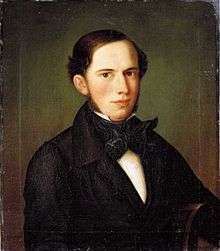Johan Sebastian Welhaven

Johan Sebastian Cammermeyer Welhaven (22 December 1807 – 21 October 1873) was a Norwegian author, poet, critic and art theorist.[1] He has been considered "one of the greatest figures in Norwegian literature."[2]
Background
Johan Welhaven was born in Bergen, Norway in 1807. His grandfather, Johan Andrew Welhaven (1748–1811) was a teacher and later assistant to the pastor at St Mary's Church (Mariakirken), which served the city's German community. The author's father, Johan Ernst Welhaven (1775–1828), was a pastor at St. George's Hospital, (St. Jørgens spedalskehospital), while his mother, Else Margaret Cammermeyer, was the daughter of Johan Sebastian Cammermeyer, resident chaplain of The Cross Church (Korskirken).[3]
Johan Welhaven was the member of an accomplished family which included his sister socialite Maren Sars, the wife of theologian and biologist Michael Sars (1805–1869), and mother of historian, Ernst Sars (1835–1917), marine biologist Georg Ossian Sars (1837–1927) and mezzosoprano singer Eva Nansen (1858–1907). Johan Welhaven was himself the father of Norwegian architect Hjalmar Welhaven.
Welhaven attended Bergen Cathedral School from 1817-25. In 1828 he began to study theology under the supervision of his father, but that same year his father died, and thus, Welhaven continued his studies at the university in the capital, where he came to live the rest of his life. After his final exams at the University of Christiania in 1827, he devoted himself to literature.
In 1836 he had visited France and Germany; and in 1858 he went to Italy to study archaeology. In 1840, he was appointed lecturer in philosophy at the Royal Frederik's University in Christiania and delivered a series of lectures on literary subjects.
When in 1843 he obtained an academic job, controversy aroused because he had not even completed his theological degree, and had not published any work of philosophical nature. Wergeland also searched for the position and completed a theological degree and used the illustrations of Creation, Man and the Messiah to show his deep historical and philosophical knowledge. He became professor in 1846.
Afterwards, he spent 26 years lecturing in philosophy at the University from 1840 to 1866. His influence was extended by his appointment as director of the Society of Arts.[4]
He died in Christiania in 1873.
Career

Welhaven made his name as a representative of conservatism in Norwegian literature in the 19th century. As shown by an attack on Henrik Wergeland's poetry, he opposed the theories of the extreme nationalists. He desired to see Norwegian culture brought into line with that of other European countries, and he himself followed the romantic tradition, being influenced by J.L. Heiberg.
He is known for his feud with Henrik Wergeland and for the poem Republikanerne ("The Republicans"). Welhaven was also romantically involved with Wergeland's younger sister Camilla Collett.[5]
He gave an exposition of his aesthetic creed in the 1834 sonnet cycle Norges Dæmring ("The Dawn of Norway"). He published a volume of Digte ("Poems") in 1839; and in 1845 Nyere Digte ("Newer Poems"). Other poems followed in 1847 Den Salige (The Blessed One), 1848, 1851 and 1859.[6] He was well known for dealing with nature and folklore, and later for poems about religion, like «En Sangers Bøn» (The Prayer of a Singer).[7] In it, he showed his spiritual side, expressiing empathy for his fellows human being and pious Christian hope with biblical allusions.
In the 1840s, Welhaven was a figure of the Norwegian national romanticism movement.[8] Welhaven helped in beginning the career of Hans Gude—a romanticist painter—as it was Welhaven who first recommended that Gude should attend the Academy of Art in Düsseldorf.[9]
Selected works
Nasjonalgalleriet
- Til Henrik Wergeland! (1830)
- Henrik Wergelands Digtekunst og Polemik ved Aktstykker oplyste, (1832)
- Norges Dæmring. Et polemisk Digt, (1834)
- Digte, (1839)
- Nyere Digte', (1845)
- Halvhundrede Digte, (1848)
- Reisebilleder og Digte, (1851)
- En Sjel i Vildmarken, (1856)
- En Digtsamling, (1860)
- Ewald og de norske Digtere, (1863)
- Samlede Skrifter, (1867–68)
- Samlede Digterværker, Jubilæumsutgave I-VI (1907, reissued in 1921)
- Samlede Digterverker I-III, (1945)
- Metaphysik i 100 Paragrafer (lecture manuscript published with comments by A. Aarnes and E.A. Wyller, 1965)
- Samlede verker 1–5 (with introduction and commentary by Ingard Hauge, 1990–1992)
References
- ↑ Johan Sebastian Welhaven (Dagbladet.no © 2003)
- ↑ Foster, Beryl. 2007. The Songs of Edvard Grieg. Boydell Press, p. 64
- ↑ Welhaven Family (Store norske leksikon)
- ↑ Johan Sebastian Welhaven /utdypning (Store norske leksikon)
- ↑ Welhaven som symptom (Morgenbladet. December 21, 2007 )
- ↑ Johan Sebastian Welhaven (Store norske leksikon)
- ↑ Jan Sjåvik, 2006. Historical Dictionary of Scandinavian Literature and Theater. Scarecrow Press. p. 285
- ↑ Anne Lene Berge, Eli Lindtner Næss and Øystein Rottem: Impuls: Norsk for VK1 og VK2, Cappelen 2001. Page 68.
- ↑ Haverkamp, Frode. Hans Fredrik Gude: From National Romanticism to Realism in Landscape (in Norwegian). trans. Joan Fuglesang.
 This article incorporates text from a publication now in the public domain: Chisholm, Hugh, ed. (1911). "Welhaven, Johann Sebastian Cammermeyer". Encyclopædia Britannica (11th ed.). Cambridge University Press.
This article incorporates text from a publication now in the public domain: Chisholm, Hugh, ed. (1911). "Welhaven, Johann Sebastian Cammermeyer". Encyclopædia Britannica (11th ed.). Cambridge University Press.
Sources
- Hauge, Ingard Demringens tolker, en essaysamling om Johan Sebastian Welhaven (with Asbjørn Aarnes og Paul Grøtvedt. 1990) ISBN 82-588-0604-1
- Vassdal, Tore Bastian, Johan Sebastian Cammermeyer Welhaven som bergenser og vestlending (2006) ISBN 82-7916-041-8
- Seip, Anne-Lise Demringstid, Johan Sebastian Welhaven og nasjonen (Aschehoug, 2007) ISBN 978-82-03-19237-1
External links
![]() Media related to Johan Sebastian Welhaven at Wikimedia Commons
Media related to Johan Sebastian Welhaven at Wikimedia Commons
- Johan Sebastian Welhaven liv og skrifter by Arne Løchen.
- Digitized books by Welhaven in the National Library of Norway